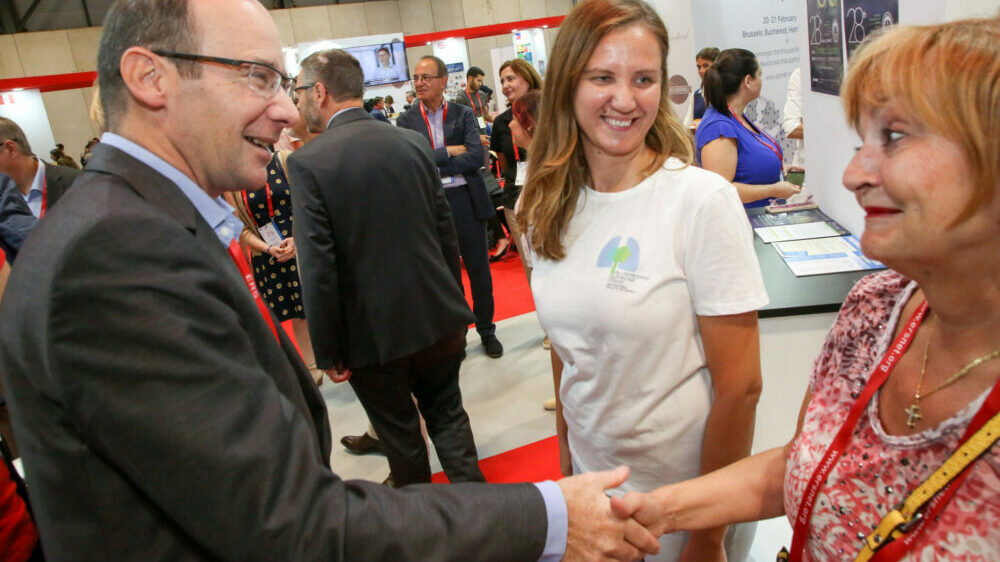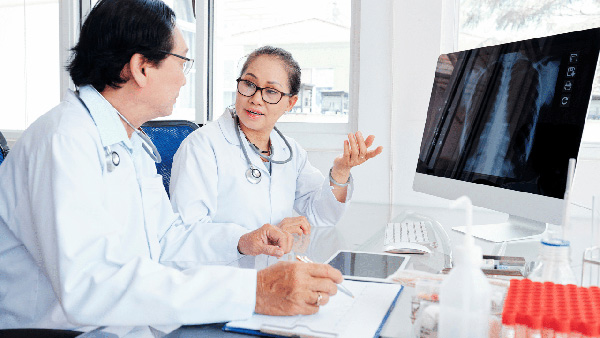About eGLILDnet
The e-GLILDnet (European Granulomatous-Lymphocytic Interstitial Lung Disease Network) Clinical Research Collaboration (CRC) was launched by the European Respiratory Society (ERS) in 2019, in association with the European Society for Immunodeficiencies (ESID), European Lung Foundation (ELF) and the International Patient Organisation for Primary Immunodeficiencies (IPOPI). e-GLILDnet is dedicated to improving the lives of those living with Granulomatous-Lymphocytic Interstitial Lung Disease (GLILD), a lung complication seen in people affected by primary immunodeficiencies (PID), such as common variable immunodeficiency disorders (CVID) and other PID with rare monogenetic defects. Currently, more than 550 monogenetic PID are known. GLILD is the lung component of a systemic immune dysregulation of CVID and other PID that result in reduced survival, is resistant to antibody replacement, and for which there is very little evidence-based therapy. GLILD symptoms can manifest in people already diagnosed with CVID or a related PID, but may also precede the diagnosis, as antibody-deficiency-related symptoms can be mild or overlooked initially. Therapeutic potential is increasing rapidly with the identification of specific mechanisms underlying GLILD or the underlying PID, such as abnormalities in PI3K (phosphoinositide 3-kinase) or CTLA4 (cytotoxic T-lymphocyte-associated protein 4) pathways, among others. Only by adopting a multi-professional Europe-wide approach in GLILD can we deliver practice-changing research and improve the lives of people living with this condition.
Specific aims
e-GLILDnet aims to provide the best possible care for people living with GLILD around the globe and of any age by:
- Optimising GLILD care through a systematic pulmonary and extrapulmonary approach in diagnostics and treatment, including geno- and immunophenotyping.
- Advancing and disseminating knowledge on GLILD by fostering collaborative research, connecting clinicians and researchers worldwide, involving patients, early career researchers and ensuring access to experts in the field for all treating physicians.
- To increase awareness for primary immunodeficiencies as a cause for interstitial lung diseases (ILD) among European pulmonologists by establishing collaborations with other CRCs within the ERS and with other European Reference Networks (ERN).
Operational aspects
To achieve the above-mentioned aims, four work packages (WP) are being composed with the following objectives:
WP1: GLILD guidelines
- Aim: to develop clinical practice guidelines on screening, diagnosis, monitoring, and therapy of GLILD that will be available for all caretakers involved in GLILD.
- Methods:
- Establish an international guideline on GLILD diagnosis using Grading of Recommendations Assessment, Development and Evaluation (GRADE) methodology.
- Establish international guideline(s) of GLILD management and treatment using GRADE methodology.
WP2: GLILD registry
- Aim: to establish a secure, privacy-compliant, and standardised data platform for the storage of patient information, with the aim of supporting future research initiatives.
- Methods:
- Harmonise diagnostics, clinical and paraclinical phenotyping of GLILD across all participating centres.
- Identify and evaluate approaches to harmonise reporting protocols for imaging and histopathological assessments.
- Implement the established data collection plan in an established international database for primary immunodeficiencies
WP3: GLILD awareness and education
- Aim: beyond fostering innovative research, the objective of e-GLILDnet is to improve healthcare equity by making currently available knowledge broadly accessible to both patients and caregivers.
- Methods: various approaches will be used, including:
- Development of multilingual education programmes for patients in at least five languages.
- Inventory of access to a multidisciplinary team (MDT) across Europe using international online surveys. For areas without access to an MDT, develop a strategic plan to ensure access.
- Facilitating educational and networking events, particularly to support and encourage early-career researchers in the field of respiratory-immunology.
WP4: GLILD collaborations
- Support and foster current and novel collaborative initiatives with other CRCs within ERS, other ERNs, patient organizations such as ELF, International Patient Organisation for Primary Immunodefiencies (IPOPI) and national patient organizations and supporting network research activities of e-GLILDnet participants.
Stakeholders
Steering Committee: includes the two CRC chairs, multi-professional clinicians and researchers from the fields of pulmonology, immunology, paediatrics, radiology and pathology, early-career researchers (one ERS, one ESID) and patient representatives from various countries in Europe and beyond.
Working groups: includes a Steering Committee member, designated lead, early career members, PhD students, patient representatives and other relevant experts.
Expert Advisory Board: comprises a partnership between the different stakeholders such as the Steering Committee, national centres leads, funding partners, scientific experts, and patient advisory groups.
Contact
If you are interested in receiving more information about e-GLILDnet or would like to join the registry, please contact scientific@ersnet.org.
Publications
- Interstitial lung disease in primary immunodeficiency: towards a brighter future
Hurst JR, Warnatz K; ERS eGLILDnet Clinical Research Collaboration. Eur Respir J. 2020 Apr 3;55(4):2000089. doi: 10.1183/13993003.00089-2020. Print 2020 Apr.
- Managing Granulomatous-Lymphocytic Interstitial Lung Disease in Common Variable Immunodeficiency Disorders: e-GLILDnet International Clinicians Survey.
van de Ven AAJM, Alfaro TM, Robinson A, Baumann U, Bergeron A, Burns SO, Condliffe AM, Fevang B, Gennery AR, Haerynck F, Jacob J, Jolles S, Malphettes M, Meignin V, Milota T, van Montfrans J, Prasse A, Quinti I, Renzoni E, Stolz D, Warnatz K, Hurst JR. Front Immunol. 2020 Nov 26;11:606333. doi: 10.3389/fimmu.2020.606333. eCollection 2020. PMID: 33324422
- Treatment Strategies for GLILD in Common Variable Immunodeficiency: A Systematic Review.
Lamers OAC, Smits BM, Leavis HL, de Bree GJ, Cunningham-Rundles C, Dalm VASH, Ho HE, Hurst JR, IJspeert H, Prevaes SMPJ, Robinson A, van Stigt AC, Terheggen-Lagro S, van de Ven AAJM, Warnatz K, van de Wijgert JHHM, van Montfrans J. Front Immunol. 2021 Apr 15;12:606099. doi: 10.3389/fimmu.2021.606099. eCollection 2021.
- Granulomatous-lymphocytic interstitial lung disease: an international research prioritisation.
Hurst JR, Abbas SH, Bintalib HM, Alfaro TM, Baumann U, Burns SO, Condliffe A, Davidsen JR, Fevang B, Gennery AR, Haerynck F, Jacob J, Jolles S, Lamers O, Bergeron A, Malphettes M, Meignin V, Milito C, Milota T, Pergent M, Prasse A, Quinti I, Renzoni E, Sediva A, Stolz D, Smits B, Strauss F, van de Ven AAJM, van Montfrans J, Warnatz K. ERJ Open Res. 2021 Dec 6;7(4):00467-2021. doi: 10.1183/23120541.00467-2021. eCollection 2021 Oct.
- Diagnostic testing for interstitial lung disease in common variable immunodeficiency: a systematic review.
Bintalib HM, van de Ven A, Jacob J, Davidsen JR, Fevang B, Hanitsch LG, Malphettes M, van Montfrans J, Maglione PJ, Milito C, Routes J, Warnatz K, Hurst JR. Front Immunol. 2023 May 8;14:1190235. doi: 10.3389/fimmu.2023.1190235. eCollection 2023.
- Current Practices and Considerations in Lung Biopsy for Suspected Granulomatous-Lymphocytic Interstitial Lung Disease: A Clinician Survey.
Bintalib HM, Davidsen JR, Van de Ven AAJM, Goddard S, Burns SO, Warnatz K, Hurst JR. Respiration. 2024;103(11):692-700. doi: 10.1159/000540101. Epub 2024 Jul 22.

 ERS Respiratory Channel
ERS Respiratory Channel
 ERS Respiratory Channel
ERS Respiratory Channel


